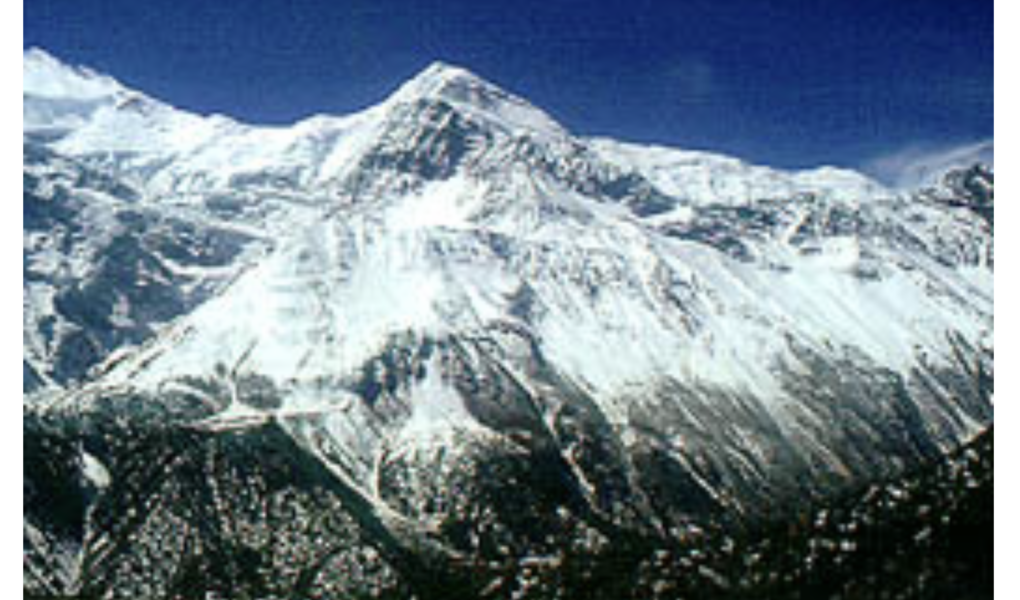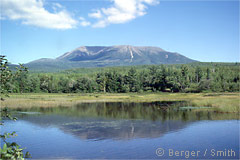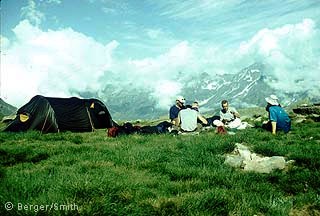It’s a three-week trip that circles around the Annapurna Massif, which are among the world’s highest mountains. Annapurna I is one of the world’s classic 8,000-meter climbs.
Logistically, this is an easy trek to arrange. From Kathmandu, you take a bus to Besishahar. From there, it’s a two-hour drive on a rutted, pitted, washed out jeep track to Syanje, where the trail actually starts. (You can also walk it; plan for a full day). Negotiating passage on a truck or four-wheel drive vehicle is generally possible because trekkers are a big part of the economy here. The details, while not exactly controllable (ours involved a drunk driver and a vehicle that had a slight problem keeping the engine running), do seem to fall into place, at least in hindsight. It didn’t seem that way when we were stuck in a creek without the proverbial paddle, and all of the trekkers were trying to push the stalled vehicle through the boulder strewn river-bed.
The general contour of the trek is to circle the massif counterclockwise by going upriver, trekking across a plateau, and then going downriver. (That summary is kind of like saying the Empire State Building is a building somewhere in New York.) The route begins with an ascent of the Marshyangdi River valley, with views of Manashlu and Himal Chuli. The trek rises from rice fields and forests to scruffier subalpine vegetation, following the same pedestrian routes of travel used by villagers. This trek was formerly roadless, but there are now roads that go almost the whole way around. A number of side trails to other, more remote villages have sprung up for trekkers who don’t want to share the path with trucks and other vehicles.
The trek then veers west, to the Manang Valley, a windswept, sandy, rocky, avalanche strewn landscape inhabited by Tibetan Buddists. This is part of the Tibetan plateau, and indeed, Tibet is just over the mountain range to the north. The trail then crosses the Thorong La (“La” means Pass), which at 17,800 feet is the highest point on the trail (now crossed by an extreme 4-wheel,drive road)n m,k,lk. After Thorong La, trekkers descend to the pilgrimage site of Muktinath, then continue down the Kali Ghandaki Valley, the world’s deepest gorge, with jaw-dropping views of the fierce-looking Dhaulagiri. This part of the trek can be done as a smaller subsection by flying or taking a vehicle into Jomson then trekking down-valley: With many guesthouses and restaurants, it’s come to be known as the Apple Pie Trek.
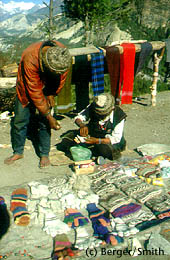 |
| Buying last minute equipment en route. |
Traditionally, trekkers stay in the small villages along the route. If you’ve booked a commercial guided expedition, you’ll probably be staying in tents pitched for you by your porters. If you’re on a private independent trek, you can carry (or hire porters to carry) tents, or you can stay in tea-houses along the way. The majority of trekkers hire porters to carry their gear. This makes the trekking easier, and porters hired independently (as opposed to pre-paid commercial expeditions) cost only about $15 – $20 US a day, depending on the trek. A guide might cost $20 – $30 a day, and he can help negotiate transport and stays at tea houses, give you cultural insights, and help with route finding and logistics on the more remote routes.
If you do book porters and guides independently, check their high altitude equipment: Many do not have adequate equipment (sunglasses, boots, warm jackets, hats), and won’t let you know until you are dependent on them, in a remote village, where some equipment may be available for sale from enterprising locals at a high prices (which you, as the employer, will be expected to pay). Also be aware that they will expect tips. Going on strike in Nepal is a time-honored porter tradition: A commercial expedition costs far more than an independently arranged one, but makes this hassle someone else’s problem.
An alternative for those who have extra time: extend the 19 – 21 day circuit with another week of trekking into the Annapurna Sanctuary itself. This takes you to the all-white world of the mountaineer, and you can stay overnight at Annapurna Base Camp. If you’re coming all this way, it is absolutely worth the additional time.
Another concern for all trekkers in Nepal is hygiene and health. Issues include contaminated water, toilet facilities, lack of available medical care, and altitude sickness.
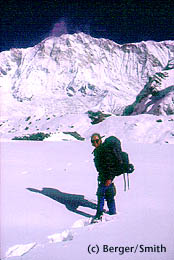 |
| In the Annapurna Sanctuary |
Nepal is not an easy destination: The entirely different culture, the hygienic problems, the sometimes limited food choices, the Sanskrit alphabet, the unfamiliar religious customs which foreigners should respect but may not understand…. all of this leads to a feeling of what the French call depayse: being out of one’s element. But the dramatic beauty of the highest mountains of earth is worth every possible traveler’s travail. Among the highlights were the views of 7,000 and 8,000 meter peaks, the climb to nearly 18,000 feet, the stark whiteness to the Annapurna Sanctuary, the emerald green of the rice fields, the rhododendron forests in bloom, the sky-piercing point of Machapuchare, and the sheer power of the raging rivers that drain the snowmelt and the remnants of avalanches. All of which, added together, put this trek securely among the top hikes in the world.
